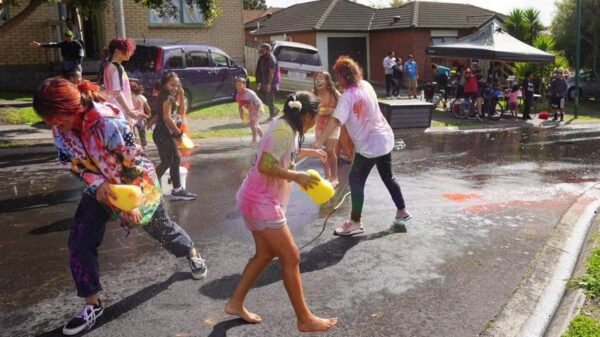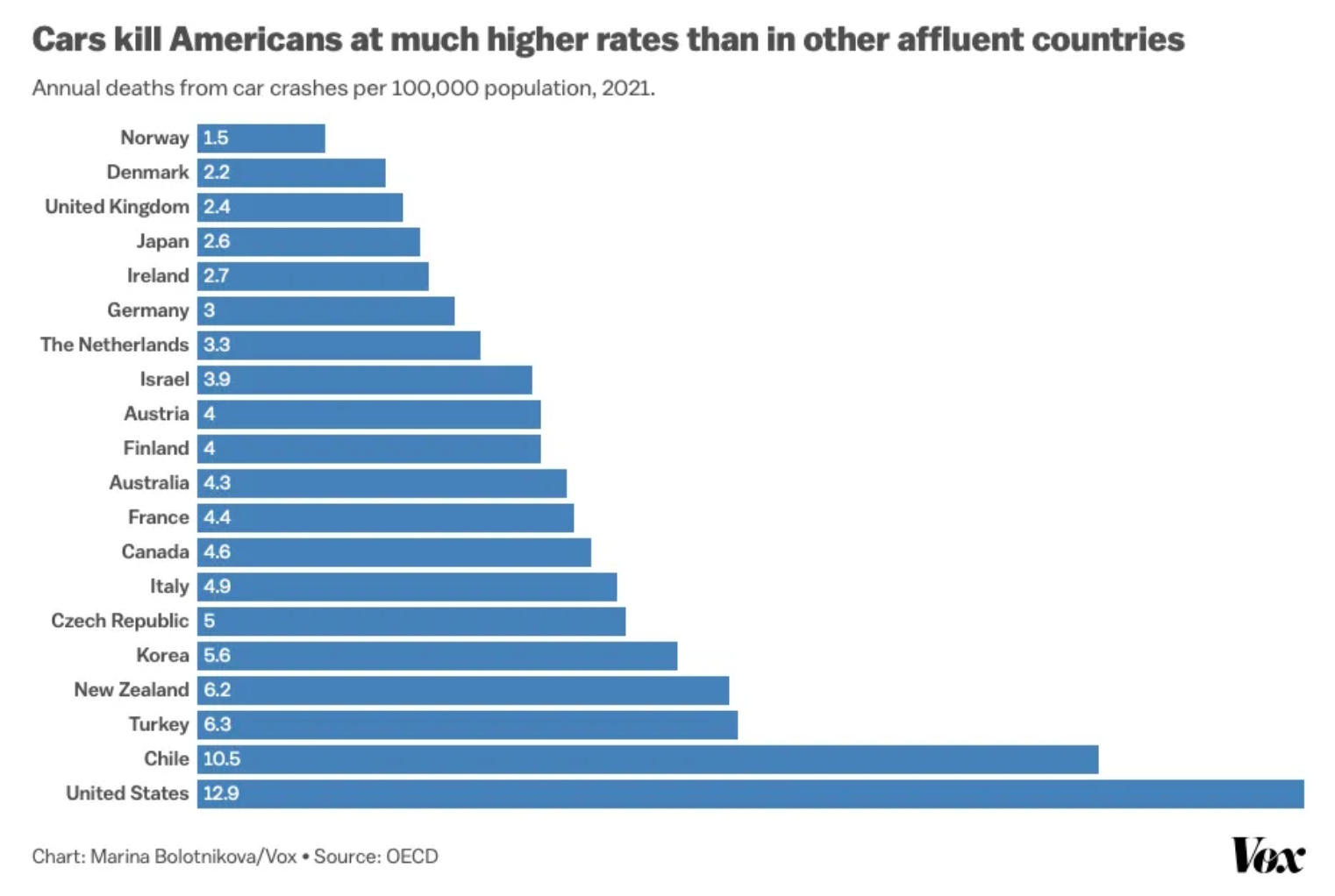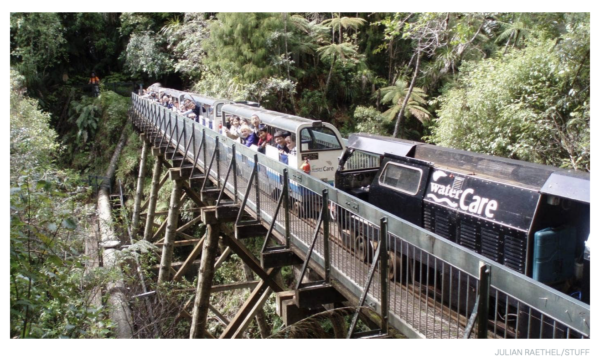Happy Friday, everyone… and happy first day of spring! This week’s header image is by Matt: a recent gorgeous sunset out west, with a glimpse of the Western Line train passing through.
A quick roundup this week with just a few stories that caught our eye; we’re a bit out of puff so we’re keeping it light for now. Bring on spring!
The week in Greater Auckland
- On Monday Matt looked at the announcement that work is (finally!) underway on a proper rapid transit corridor for the Northwest.
- On Tuesday Matt covered the highlights from AT’s latest Board meeting.
- On Wednesday Matt went through AT’s draft Auckland Rapid Transit Plan.
- And on Thursday, Matt looked at the consultation on Stage 4 of the Eastern Busway.
Play time!
Let’s start with a lovely story in Stuff about community play streets, which will be much easier to run thanks to new rules put in place just in time for daylight savings fun. As Jacquelyn Collins from Auckland Council notes, the pilot events showed that “play” is diverse, and brings communities together:
“One street in South Auckland had a volleyball court; another one did an Indian festival. And in the first one in Avondale, my kids took part in a massive chalk drawing. But there was a lot of loose play and street football, girls on roller skates. Giving kids that space to play provides opportunities.
“This really is for the kids. We can make things better for children today, and that’s an attitude change we need, not just in local government, but in the community at large. Children can be playful in public spaces.

Election season
Election campaigning is now under way, with policies coming thick and fast. This week alone, the Greens released their Climate-Safe Communities policy which includes funding for “sponge city” planting to mitigate flooding in towns and cities, and street-running light rail for Auckland, Wellington, and Christchurch.
Labour started the week by filleting government budgets including a large chunk of the Climate Emergency Response Fund, to the surprise of the Greens – whose co-leader James Shaw pointed out the worrying consequences for climate-friendly transport.
Not to be outdone, National came out with a plan to (among other things) raise public transport fares by removing the subsidies for youth, disabled people and low-income people in order to put money money in people’s back pocket to, well, pay for things like public transport.
National also proposes ditching the Regional Fuel Tax for Auckland, and has floated a misleadingly named “carbon dividend” – which, as explained by Marc Daalder at Newsroom, would simply redirect climate polluter levies into general tax cuts, rather than into climate action as intended. The Greens (and ACT) were not impressed with that, either.
See also today’s piece by Marc Daalder about how the two major parties are kicking the climate can down the road.
New Zealanders deserve an election in which climate change plays a major role. They deserve parties taking the issue seriously, rather than trading it off against tax cuts and fiscal headroom.
Sadly, that seems unlikely to happen this year.
If you listen hard enough, you can actually hear the tin can clanking its way down the road. It’s just barely audible over the gale-force winds of the next looming climate disaster.
Keen to keep track of the various policies on transport and what they mean for public health? The Public Health Communication Centre Aotearoa has a great overview here, including things like whether parties support e-bike subsidies.
Sounds familiar…
Seattle’s just released its draft 20-year transportation plan and as some of the coverage notes, every generation seems to come to the same conclusion. The challenge is in actually doing what the plan calls for:
… today’s residents echo some of their forebears, as expressed in the words of a report by the 2000 Seattle Commission, published in 1973:
“Individual motor vehicles, in their consumption of land and energy resources, imposition of visual blight and physically dividing barriers, creation of vehicular congestion, noise, air pollution and more tangible hazards to life and safety, are the most disruptive present means of transportation in the city.”
So, for example, [in the 2023 plan], “Making space for pedestrians on the city’s streets was the number one most responded-to option when participants were asked which specific actions they’d support, while readying the city’s streets for ‘emerging technologies,’ like autonomous vehicles, ranked last.”
The bigger you are and the faster you go…
The Spinoff took an interesting tour this week through some of New Zealand’s graphic and shocking road safety ads from the last couple of decades. They’re strong stuff, but they’re not the sole solution for safer roads…
…you only have to look at this chart from a recent story by Vox – about what the US could learn from air safety practices about fixing safety on its deadly roads – to see that we’re still punching horribly above our weight.

Meanwhile, across the Tasman, the state of Victoria is looking at introducing levies on SUVs to help address the rising number of deaths and serious injuries on their roads.
New and wide-ranging research from Belgium confirms what we already know: bigger vehicles cause more harm to those outside them, with “the risk of serious injury increasing by 90 per cent and the risk of fatal injuries increasing by almost 200 per cent when a pedestrian or cyclist is hit by a pick-up vehicle.”
The growing size of vehicles, aka “autobesity“, means they’re not just more dangerous to the places and people they plough through, they’re also becoming too large for existing parking spaces. Where will it end?
Go Green
A nice read about urban rewilding in Europe, restoring green spaces in cities. And from the New York Times, a lovely piece about “pocket forests“, dense but small plantings of native trees and shrubs that grow fast and nurture wildlife and wonder:
Healthy woodlands absorb carbon dioxide, clean the air and provide for wildlife. But these tiny forests promise even more.
They can grow as quickly as ten times the speed of conventional tree plantations, enabling them to support more birds, animals and insects, and to sequester more carbon, while requiring no weeding or watering after the first three years, their creators said.
Perhaps more important for urban areas, tiny forests can help lower temperatures in places where pavement, buildings and concrete surfaces absorb and retain heat from the sun.
Two Wheels Good, Electric Wheels Better?
This week’s “e-bikes rule” article is by a London commuter who runs an experiment to find out if an e-bike can match or beat his commute via train or taxi. What do you reckon?
Travel Corner
In which a New Zealand family discovers the joys of trains on a long-planned trip abroad:
After seven years of not leaving New Zealand, we were heading on a trip to visit relatives and friends in Northern Ireland, Scotland, England and Germany. We baulked at the massive carbon footprint the flights once around the world would produce. But grannies had to be visited, friends reconnected with and our kids introduced to where their parents come from. While there wasn’t much we could do about the impact of our long-haul flights, we vowed to make more conscious decisions once we were in Europe.
…
Some rail networks (like Germany’s Deutsche Bahn) have dedicated family areas. We loved that we didn’t have to worry if our kids crawled over seats or had big emotions.”
And a thoughtful piece on how to travel responsibly in this climate-conscious age: in short, fly less, stay longer, make it count, and give back.
Auckland’s Climate Festival
The third iteration of the Auckland Climate Festival Te Huinga Aahuarangi o Taamaki Makaurau is under way, with an opening ceremony at the Botanic Gardens yesterday. The festival runs for a month, with over 150 activations, events and pop-ups on every climate angle you can imagine.
At the opening ceremony, Councillor Richard Hills spoke about how “everything changed” on the night of 27 January this year. As reported by Stuff:
Hills says of the floods, that the challenge and riddle the water gave us, was that it took the pathways through the city that many of the original awa, or streams, used to take. That was “Before we shoved them all into pipes, covered them in roads and put houses in the way.”
…
“Some people will tell you that adaptation is only where we should be focusing now, but people need to realise these disasters, droughts and storms, the issues we’re facing as a city and a country are at 1.5 degree of warming. We don’t want to get into two, three and four degrees. We need to reduce our emissions,”
Of particular interest to GA readers will be the conversation “Transporting us to a Cooler Future” (at the Town Hall on Wednesday 20 September, 5.30-7.30pm). Check out the whole programme for tons of interesting sessions.
Getting trains back on track
With Te Huia now back up and running properly to the city centre, ridership has rebounded, and new stats suggest it’s the country’s most satisfying train service:
Since the service resumed travel into central Auckland from August 7 after a four-week interruption, passenger volumes have been between 30 and 50 per cent up on the June 2023 weekly average of 1349.
There has been an increase on the previous year’s [customer satisfaction] scores, with an overall satisfaction rating of 98 per cent, up from 94 per cent in 2022. The result is well above the key performance indicator of 90 per cent.
Who remembers the tiny tourist train that ran through the Waitākere Ranges, giving visitors a different view of the trees and the dams? It’s been on pause for a decade due to risks of the terrain, which were only exacerbated by recent weather events. As reported by Stuff, there’s a push to at least retrieve and restore the equipment, in the hopes the Rainforest Express can one day run again.

The Texture of our Towns
Toby Morris, who’s produced brilliant work at The Spinoff, is headed to fresh ventures. His parting gift is “Signs of Life”: a beautiful story of a man responsible for the visual texture of a town. It’s a very human insight into the kind of detail that quietly enriches the everyday surfaces of our towns and cities. Enjoy.


 Processing...
Processing...
In other news this week, Labour has cut $50 million for supporting local councils to build walkable neighbourhoods and cycle networks, amongst other climate related spending cuts. https://www.newsroom.co.nz/labours-mixed-messages-on-communication-breakdown-with-greens?utm_medium=Social&utm_source=Twitter#Echobox=1693264988-1
Have Labour paid for any cycling or walking infrastructure? Much more seemed to be happening under National! However I think Bridges was a hell of a lot better than Simeon Brown will be.
Bridges has probably been NZ best transport minister in the last 20 years? Not a very high bar.
Bridges actively tried to suppress the business case for the third main. First tried to hide it altogether, then released a “redacted version” full of black lines before finally being forced to release the report untampered. The report of course recommended the project go ahead and would be even better with 4 tracks. Zero happened until the National government was removed and now it is finally nearing completion. This is just one example of your “best transport minister in the last 20 years” Laughable.
And don’t forget the 10 bridges that weren’t built in the North , hence his nickname Simon “No”Bridges .
And I thought that this spawned his title of Minister of Roads and Bridges.
eScooter are the more gutless road users in Auckland, they own the roads, they own the footpath they own the hallways in the appartment building.
Once soe years ago, I was on a inner link bus, the green bus, he had trouble getting down parnell rise into Beach road, right up the head of the queue was a eShooter user holding up traffic behind him.
Once I saw a eScooter user follow a ambulance throught traffic lights when other road users (Cars) wanting to use the same route as the eScooter obeyed the read traffic lights.
Once one eScooter ordered me to get out of the way bottom of Queen Street when he had lots of space to get around me.
They often block the footpaths.
What a shame NZ is not a state of America, [the rest has been self moderated]
Sounds really bad Eric! Once I saw a car blocking an intersection holding up multiple buses with hundreds of people on them, also seen cars crash too and kill people, seen cars go through red lights a few times and wow i think i have seen a car or two block a footpath.
Slight over exaggeration there ‘owning the roads’.
E-scooters have their place for mobility. And arguably should have meant cities rolling out cycling infrastructure faster as there was a new ‘user’ found.
But Auckland didn’t embrace them, and yes, they’re finding their place anywhere.
Set parking areas with plenty of safe cycle paths would be the idea.
Its not just the users, those who charge them and put them back on the streets often leave them blocking cycle lanes, and more than occasionally place them around blind bends. They get placed on the cycleway around Ian McKinnon Drive in the section thats not a shared pedestrian zone – How is a pedestrian supposed to get to the scooter…
The next most inconsiderate are eBikes, e.g. the person who overtook me this morning on the uphill relatively narrow section of cycleway between Myrtle St and Mountain View Rd, while there was an oncoming cyclist. Second closest near miss I’ve ever seen short of a crash. Closest was another ebike on the Ian McKinnon section.
Quite possibly that the scooter rider holding up traffic was speed restricted to 15kph by the geofencing software designed to protect pedestrians and riders alike.
At least if he loses it and ploughs into a bus stop, the damage is unlikely to be life threatening.
RE: “… started the week by filleting government budgets including a large chunk of the Climate Emergency Response Fund.”
From Newsroom – “One unusual aspect of the move is that climate funding is supposed to be ring-fenced solely for climate policies, but the savings will instead be returned to the general coffers.”
https://www.newsroom.co.nz/pro/govt-cuts-further-236-million-from-climate-policies
The other major political party is also proposing to use ring-fenced climate funding for other purposes.
Simply unacceptable.
A bit of nostalgia for those that can remember what Auckland Public Transport was like ;-
And here is what is happening above and below K’rd , and right now they are installing the linings along the platforms . And around November the tracks will start to be laid .
https://www.1news.co.nz/2023/08/31/kiwirail-rejects-nzta-account-of-potential-te-huia-train-collision/
Ten trains have gone through a red this year. Only Te Huia faced any sanctions and that appears to be based on BS.
And this from RNZ ;-
At the time Te Huia was sanctioned over safety concerns on 11 July, Waka Kotahi knew of eight other passenger trains which ran red lights earlier in the year.
Information provided by Waka Kotahi to RNZ under the Official Information Act showed between 1 January and the beginning of July, 27 other red signal events were reported across the network. Two of these were Te Huia, two were other Auckland metro trains and six were Wellington metro trains.
The other 17 incidents involved freight trains and maintenance vehicles in locations such as Tauranga, Mt Eden, Huntly and Dunedin.
https://www.rnz.co.nz/news/national/496817/te-huia-the-only-train-service-sanctioned-over-signal-passed-at-danger-events
Hope we see some Community Play Streets showcasing how we might make our suburbs better places to live. Might I suggest Maki St at Westgate should be considered, rode up there today and was shocked at how this ” shared space” is now completely dominated by cars rat running, parking and treating those on foot with disdain.
I’m voting for the tax break
Good, we all need to eat more fruit and vegetables.
And watch the GST rise like when Key gave us tax break , whih was a joke for the lowely paid only his rich mates saw any thing .
What about when Labour lifted taxes by cancelling Bill English’s tax adjustments? Or is that not how this works?
Interesting stuf as always.
I adore that you informed me about this article since I think it’s amazing. That is exactly what I was hoping to discover, and I sincerely hope you will continue to share such excellent stuff in the years to come.